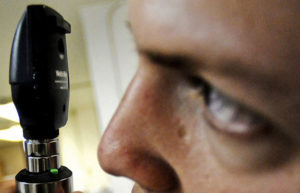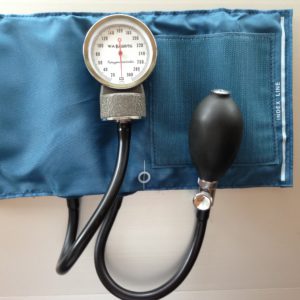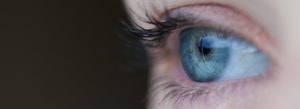A Guide to Glaucoma (Part 2)

Who is at Risk and Preventing Glaucoma-Related Vision Loss
Currently, 3 million people in the United States (and 60 million people worldwide) have glaucoma and half of them do not even know it. These numbers are expected to increase to 4.3 million by 2032 (up 50%) and rise to 5.5 million by 2050 (up 90%). However, some people have a higher risk of developing glaucoma than others, and there are steps you can take to lower your risk of getting glaucoma and preventing vision loss.
Who’s at Risk for Getting Glaucoma
Anyone can get glaucoma, but some people have a higher risk of getting glaucoma, including age, race, health, and family history. Here is how certain factors increase your risk for glaucoma.
Age (Anyone over 60 Years old)
 As your eyes age, your risk of developing glaucoma increases. This is especially true for everyone over 60 years old and particularly true for non-white people over 40 years old. At 40 your vision may change and you may begin to notice symptoms of different eye conditions. At 60 years old you are 6 times more likely to get glaucoma. As you age, talk to your doctor about your risk of glaucoma, and be sure to get your eyes checked.
As your eyes age, your risk of developing glaucoma increases. This is especially true for everyone over 60 years old and particularly true for non-white people over 40 years old. At 40 your vision may change and you may begin to notice symptoms of different eye conditions. At 60 years old you are 6 times more likely to get glaucoma. As you age, talk to your doctor about your risk of glaucoma, and be sure to get your eyes checked.
Race (Non-Whites are at a greater risk for glaucoma)
Certain races and ethnicities have greater risks for developing glaucoma. African-Americans are 6 to 8 times more likely to get glaucoma than whites. Non-whites have greater risks of getting glaucoma (especially people of African, Asian or Hispanic descent). Currently, more than 60% of people with glaucoma are white, but by 2050 studies predict that most people with glaucoma will be non-white due to rising numbers of Hispanics being diagnosed with glaucoma. Since race is a factor for increased risk of glaucoma, non-whites should start getting their eyes checked annually beginning at age 40.
Family History of Glaucoma
Glaucoma can be hereditary. Having a family history of glaucoma increases your chances of getting glaucoma between 4 to 9 times. New studies have found specific genes that cause glaucoma. If glaucoma runs in your family you have a higher chance of developing this disease; get your eyes checked.
Health Issues (and Eye Problems)
People with certain health issues, such as problems with blood flow, high blood pressure, diabetes, heart disease, severe anemia and hypothyroidism are all at greater risk for developing glaucoma. A prolonged use of steroids and certain other medications may also increase your risk for this disease. Other eye problems such as severe nearsightedness and previous eye injuries (retinal detachment, eye tumors, eye inflammations) and even eye surgery are all risk factors that increase your chances of developing glaucoma. If you have any of these health issues, talk to your doctor about your increased risk for glaucoma and be sure to get your eyes checked.
How to Prevent Vision Loss from Glaucoma
The good news is that vision loss due to glaucoma is very preventable. Today there are many treatments to control glaucoma and prevent further eye damage, but treatment cannot reverse damage already caused by glaucoma.
Get a Comprehensive Dilated Eye Exam
The best way to find out if you have glaucoma and to prevent vision loss from this disease is to get a comprehensive dilated eye exam from a qualified eye care professional (ophthalmologist, optometrist). The American Academy of Opthalmology recommends you have an in-depth baseline eye exam at 40 years old.
 If you wear glasses or contact lenses, most likely your eye doctor regularly screens you for glaucoma. However, if you don’t wear glasses or see an eye doctor, you should make an appointment to get your eyes examined annually.
If you wear glasses or contact lenses, most likely your eye doctor regularly screens you for glaucoma. However, if you don’t wear glasses or see an eye doctor, you should make an appointment to get your eyes examined annually.
If you notice the one thing that is repeated most often in this guide to glaucoma, it is to get your eyes checked. This is your best chance to diagnose and defend against vision loss due to glaucoma.
(We will talk more about what happens in a comprehensive dilated eye exam and how you eye doctor tests for glaucoma in Part 3 of this Guide to Glaucoma series.)
Eat a Healthy Diet (with lots of dark, leafy greens and little sodium or caffeine)
What we eat (and drink) has a direct link to our eye health. Just as a healthy diet filled with vitamins and nutrients will improve your overall health, it will also improve your eye health and can help you prevent glaucoma and glaucoma-related vision loss.
A recent study by Brigham and Women’s Hospital and Harvard Medical School published in JAMA Ophthalmology shows that nitrates lower glaucoma risk. The study found that people who ate the most dark, green leafy vegetables reduced their risk of getting glaucoma by up to 30%. Nitric oxide helps regulate the blood flow to the eye. This study found people with glaucoma have lower nitrate oxide production in the eye.
 In order to increase the amount of nitric oxide in your body and to lower your risk of glaucoma, researchers recommend that you eat (at least 1.5 servings) vegetables high in nitric oxide every day. These vegetables are loaded with nitric oxide:
In order to increase the amount of nitric oxide in your body and to lower your risk of glaucoma, researchers recommend that you eat (at least 1.5 servings) vegetables high in nitric oxide every day. These vegetables are loaded with nitric oxide:
- Spinach
- Kale
- Lettuce
- Collard greens
- Celery
- Broccoli
- Brussels sprouts
- Cabbage
- Parsley
- Peas
- Green beans
- Carrots
- Beets
- Radishes
Caffeine and sodium are found to raise blood pressure and can increase the pressure (intraocular hypertension) in your eyes. Decreasing your caffeine and sodium levels and limiting the amount of salt and caffeine you consume can help prevent vision loss due to glaucoma.
Get Plenty of Exercise (but beware of certain positions that have your head facing down for long periods of time).
Exercise improves blood flow, reduces risk of hypertension, diabetes, and other factors related to increased risk of glaucoma and glaucoma-related vision loss.
Aerobic exercise is even found to lower your intraocular pressure (IOP). Researchers find aerobic exercise (such as walking, jogging, bicycling and swimming) three times a week for 20 to 30 minutes with increased heart and breath rates will greatly reduce your eye pressure. It is important to also note that lower eye pressure is only a benefit while you continue to exercise regularly.
Not all exercises are good for you if you have glaucoma. Studies find upside down poses increase your intraocular pressure and warn you to ask your doctor about head-down yoga positions, inversion chairs, push-ups and weightlifting if you have glaucoma.
Regular exercise is great for your health and can reduce your risk for developing glaucoma. Good tips for when exercising to reduce strain on your eye pressure are to avoid exercises that put your head below your heart and do not hold your breath (breathe continuously) while exercising.
Maintain Your Health
Maintaining your health is an important factor in maintaining your vision. There are many health conditions that increase your risk for glaucoma. Preventing health conditions from flaring up can also prevent vision loss.
Control Your Diabetes
Controlling diabetes can reduce your risk for glaucoma, and if you have glaucoma, controlling your diabetes can reduce your risk of vision loss. Diabetics are 40%-50% more likely to develop glaucoma than non-diabetics. A summary of 47 different studies concluded that diabetes significantly increases your risk for glaucoma and higher intraocular pressure.
If your diabetes is uncontrolled for long enough, it will lead to diabetic retinopathy, and you can develop blood vessels in the eye that disrupt normal eye drainage, leading to increased eye pressure and glaucoma (specifically neovascular glaucoma).
Controlling your diabetes and reducing your insulin resistance can decrease eye pressure and prevent vision loss due to diabetic retinopathy and glaucoma. If you have diabetes it is very important that you get your eyes examined annually.
Reduce Your Blood Pressure (especially your Ocular Hypertension)
Having high blood pressure (or hypertension) increases your risk for glaucoma.
Studies suggest that the relationship between your eye and blood pressure (ocular perfusion) can be a strong risk factor for glaucoma. Most people easily adapt to changes in blood pressure to maintain circulation of blood to the brain and eyes, but some people do not adjust properly and this can lead to ocular hypertension and damage the eyes.
 Risk factors for ocular hypertension include:
Risk factors for ocular hypertension include:
- High blood pressure
- Smoking
- Diabetes
- Stress
- Consuming too much salt, hydrogenated oils, trans fats, red meat, alcohol, sugar
- Certain medications
- Heart disease
- Eye trauma
- Eye conditions
Reducing these risk factors and regulating you blood pressure (especially to your eyes) is very important to preventing vision loss due to glaucoma.
Get Tested for Sleep Apnea
Researchers in Taiwan at Taipei Medical University in 2013 found that people with a diagnosis of sleep apnea are 1.67 times more likely (than people without sleep apnea) to develop open-angle glaucoma within 5 years. A second study in China in 2015 found a 72% increased risk of glaucoma for people with diagnosed sleep apnea.
Sleep apnea is a chronic condition where your airways become blocked and you stop breathing for up to 2 minutes at a time while you are sleeping. This sleep disorder affects 22 million people in the United States and 100 million people worldwide. Sleep apnea symptoms include snoring, choking or gasping for air while sleeping and daytime sleepiness and headaches.
Researchers believe that the lack of oxygen caused by sleep apnea (hypoxia) increases hypertension and eye pressure, both of which causes damage to the optic nerve. Because the body must work harder to get oxygen to its organs and tissues the blood vessels and heart constrict increasing blood and eye pressure.
If you have sleep apnea, talk to your doctor about your increased risk for glaucoma and be sure to get a comprehensive dilated eye exam.
Stop Smoking
Smoking is the largest preventable cause of death and disease. Smoking harms your eyes and greatly increases your risk of developing open angle glaucoma. Studies show that smoking increases your intraocular pressure and your chances of developing glaucoma. There is also a strong connection between smoking and high blood pressure, diabetes and cataracts—all risk factors for glaucoma. Quitting smoking is a great way to protect your vision and reduce your risk for glaucoma.
Talk With Your Healthcare Professional
If you are concerned about developing glaucoma or vision loss due to glaucoma, the best advice is to talk with your healthcare professional. Talk with your doctor about your overall health, any medications you are taking and how they are affecting you, and tell your doctor about any changes overall in your condition. If your doctor has prescribed any treatment for you, be sure to follow it—even if you do not experience any vision loss symptoms. Being open, asking questions, sharing information with your doctor and monitoring your overall health and eye health is a great way to maintain healthy vision and prevent vision loss due to glaucoma.
 For most people, vision loss due to glaucoma is very preventable. There are many things that you can do to reduce your risks of getting glaucoma and to prevent vision loss from glaucoma.
For most people, vision loss due to glaucoma is very preventable. There are many things that you can do to reduce your risks of getting glaucoma and to prevent vision loss from glaucoma.
However, there are a few people will experience vision loss no matter what they do. The American Academy of Ophthalmology estimates that 1 in 10 people with glaucoma will eventually lose their sight.
If you do experience vision loss from glaucoma, there are many great low vision aids and blindness aids to help you live a full, independent life. We will discuss low vision and blindness technology for glaucoma in Part 4 of this series.
As part of our work to increase awareness about glaucoma and glaucoma-related vision loss and living with glaucoma we have written a 4-part Guide to Glaucoma. Please share this Guide with friends and remember to get your eyes tested for glaucoma annually. If you do have glaucoma-related vision loss, call us at 888-211-6933 to learn how low vision aids can help you.
In Part One of our series “A Guide to Glaucoma” we discussed what glaucoma is, the warning signs and symptoms of glaucoma and the stages of glaucoma related vision loss.
In Part Three of our Glaucoma Guide we discuss tests and treatments for glaucoma.
In Part Four of our Glaucoma Guide we discuss how glaucoma affects your vision and low vision and blindness aids for people with vision loss from glaucoma.



